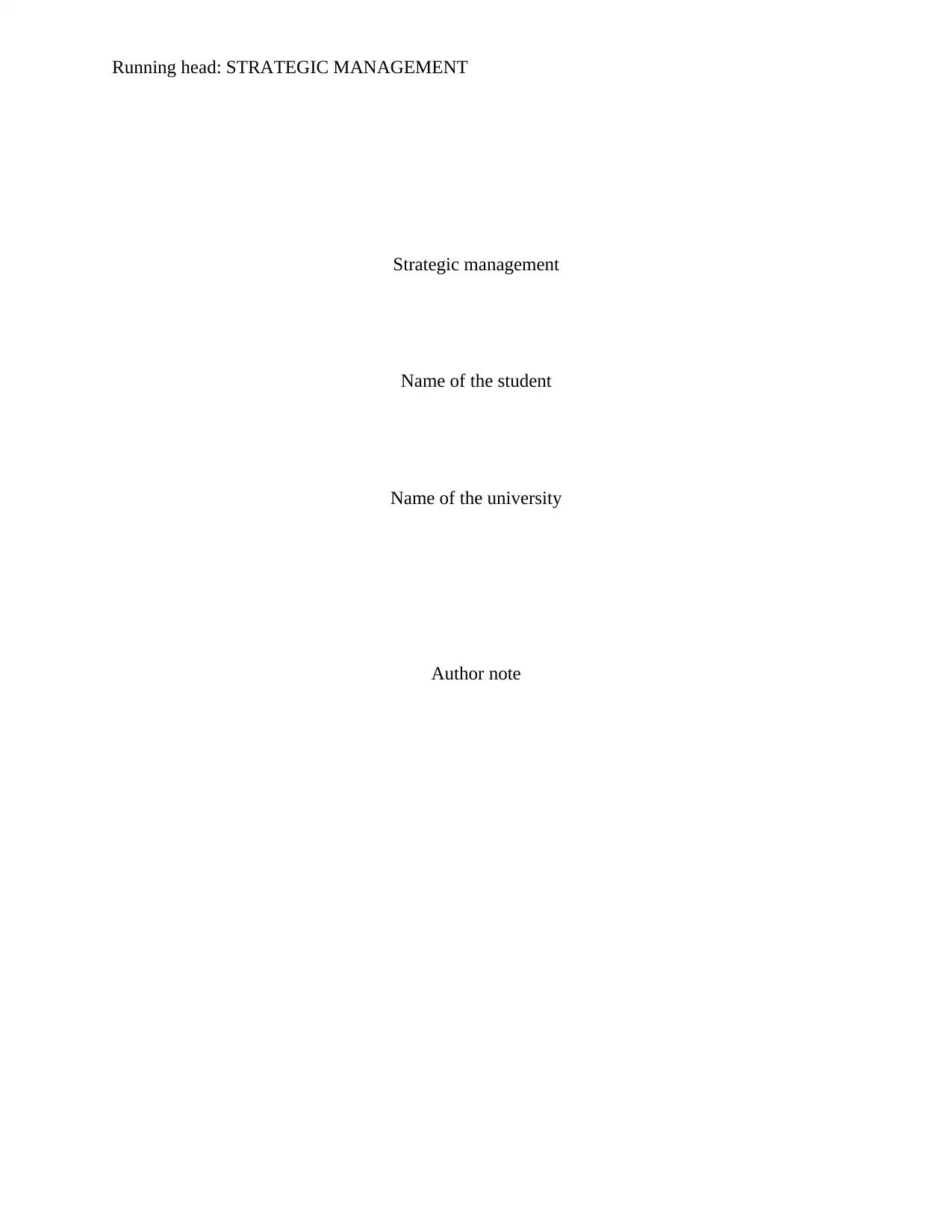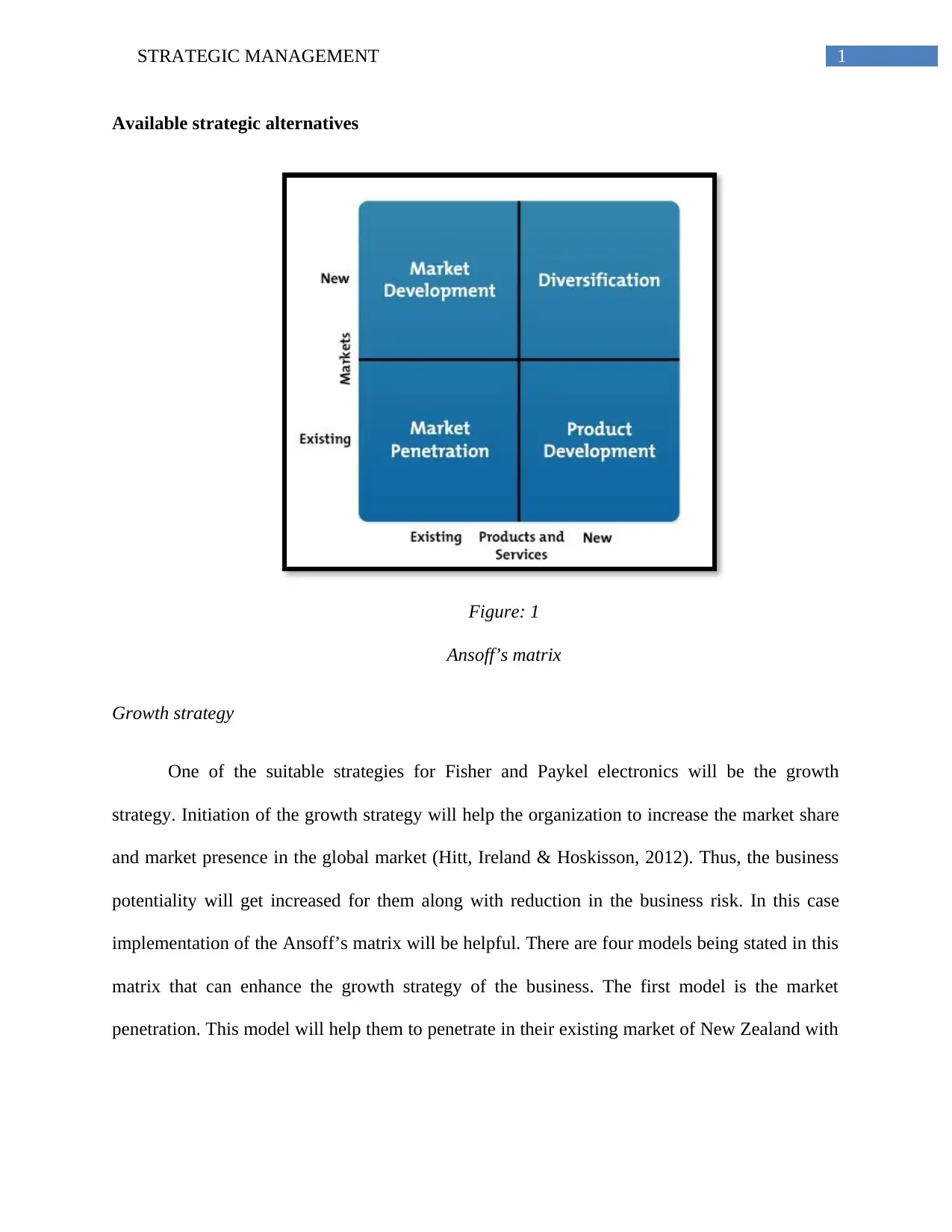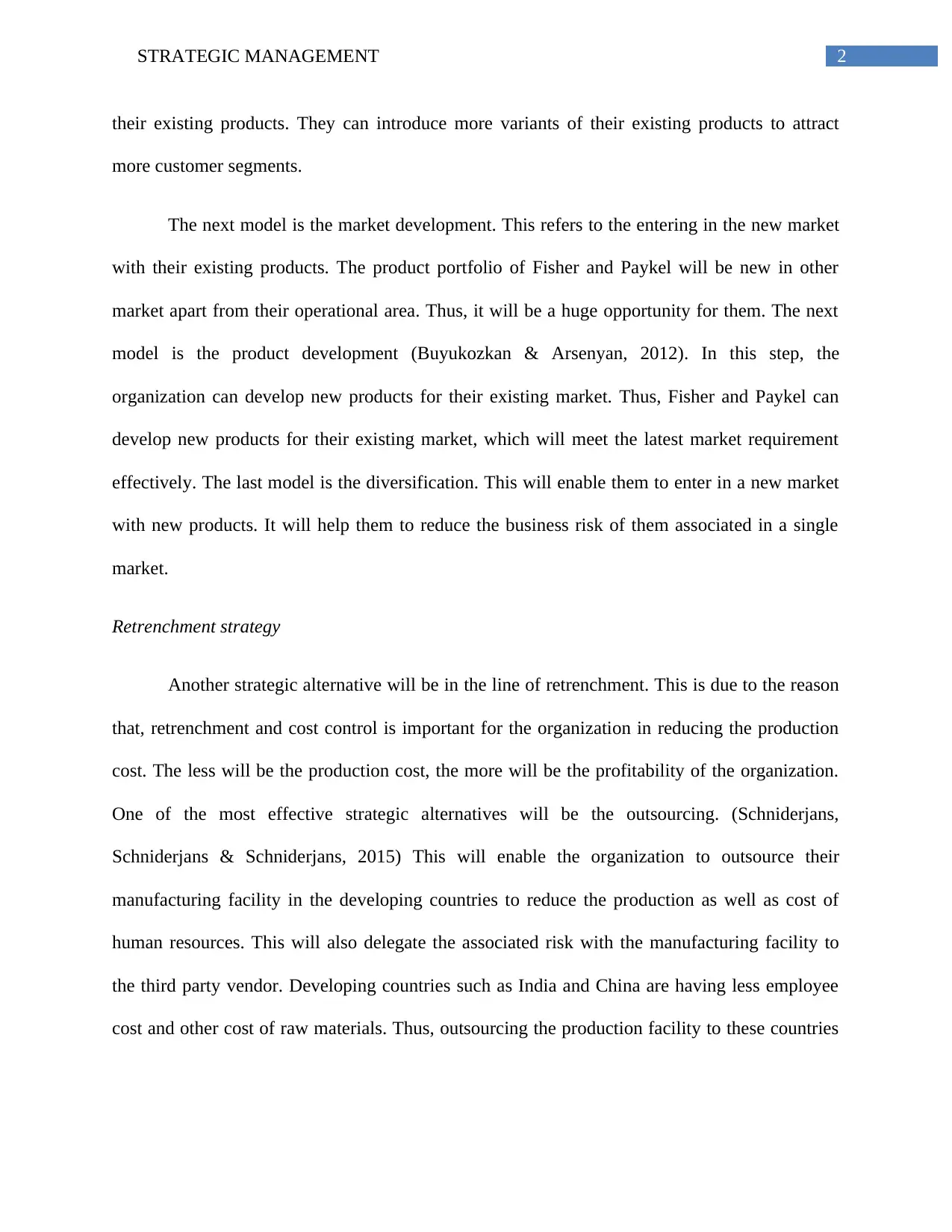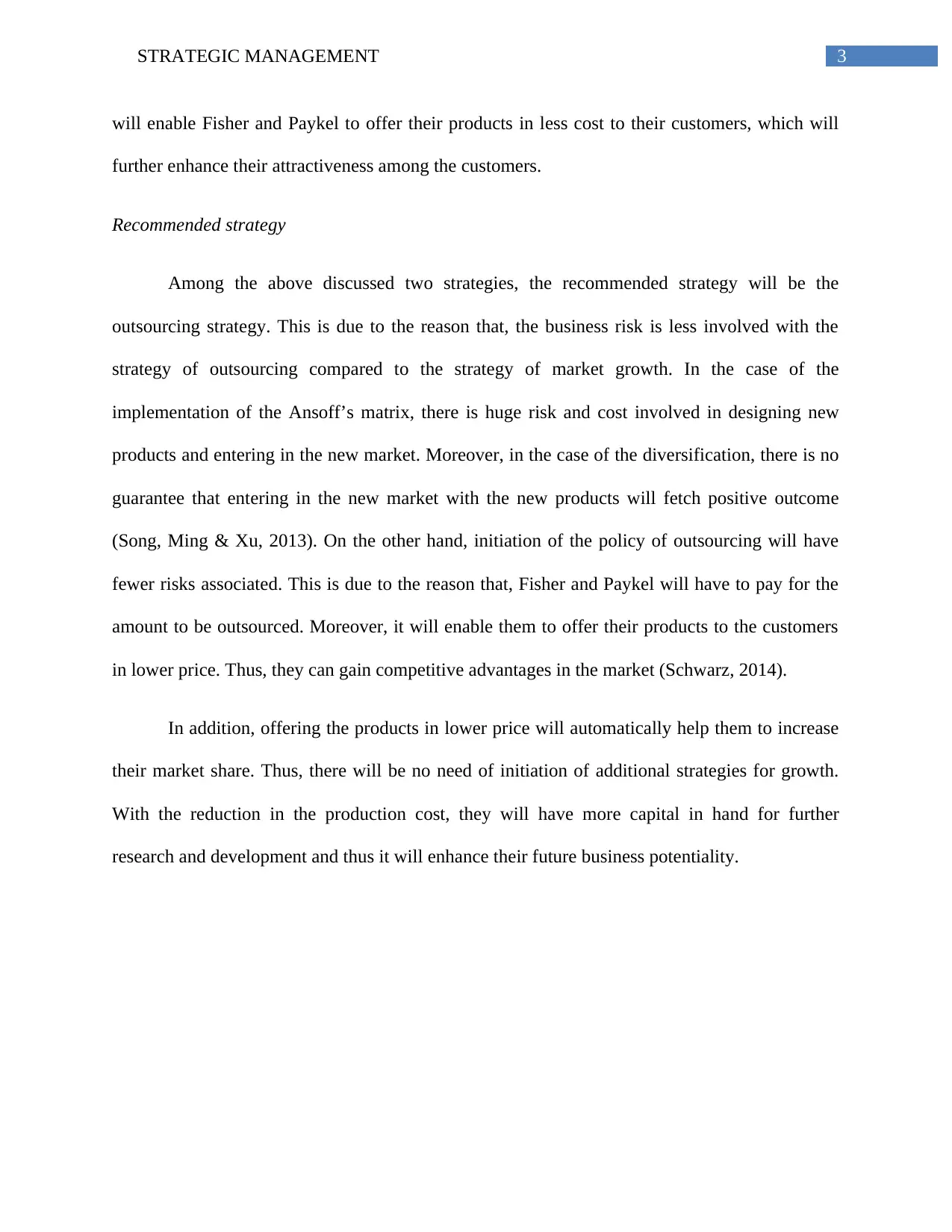Strategic Management Report: Evaluating Fisher and Paykel's Strategies
VerifiedAdded on 2020/05/04
|5
|898
|38
Report
AI Summary
This report provides a strategic analysis of Fisher and Paykel Electronics, evaluating suitable strategic alternatives for the company's growth and competitiveness. The report explores two main strategic approaches: growth and retrenchment. The growth strategy is examined through the lens of Ansoff's matrix, considering market penetration, market development, product development, and diversification. The retrenchment strategy focuses on cost control, particularly through outsourcing. The report recommends the outsourcing strategy as the preferred approach, highlighting its lower risk profile and potential for competitive advantages through reduced production costs and increased market share. The report concludes by emphasizing the importance of capital allocation for future research and development.

Running head: STRATEGIC MANAGEMENT
Strategic management
Name of the student
Name of the university
Author note
Strategic management
Name of the student
Name of the university
Author note
Paraphrase This Document
Need a fresh take? Get an instant paraphrase of this document with our AI Paraphraser

1STRATEGIC MANAGEMENT
Available strategic alternatives
Figure: 1
Ansoff’s matrix
Growth strategy
One of the suitable strategies for Fisher and Paykel electronics will be the growth
strategy. Initiation of the growth strategy will help the organization to increase the market share
and market presence in the global market (Hitt, Ireland & Hoskisson, 2012). Thus, the business
potentiality will get increased for them along with reduction in the business risk. In this case
implementation of the Ansoff’s matrix will be helpful. There are four models being stated in this
matrix that can enhance the growth strategy of the business. The first model is the market
penetration. This model will help them to penetrate in their existing market of New Zealand with
Available strategic alternatives
Figure: 1
Ansoff’s matrix
Growth strategy
One of the suitable strategies for Fisher and Paykel electronics will be the growth
strategy. Initiation of the growth strategy will help the organization to increase the market share
and market presence in the global market (Hitt, Ireland & Hoskisson, 2012). Thus, the business
potentiality will get increased for them along with reduction in the business risk. In this case
implementation of the Ansoff’s matrix will be helpful. There are four models being stated in this
matrix that can enhance the growth strategy of the business. The first model is the market
penetration. This model will help them to penetrate in their existing market of New Zealand with

2STRATEGIC MANAGEMENT
their existing products. They can introduce more variants of their existing products to attract
more customer segments.
The next model is the market development. This refers to the entering in the new market
with their existing products. The product portfolio of Fisher and Paykel will be new in other
market apart from their operational area. Thus, it will be a huge opportunity for them. The next
model is the product development (Buyukozkan & Arsenyan, 2012). In this step, the
organization can develop new products for their existing market. Thus, Fisher and Paykel can
develop new products for their existing market, which will meet the latest market requirement
effectively. The last model is the diversification. This will enable them to enter in a new market
with new products. It will help them to reduce the business risk of them associated in a single
market.
Retrenchment strategy
Another strategic alternative will be in the line of retrenchment. This is due to the reason
that, retrenchment and cost control is important for the organization in reducing the production
cost. The less will be the production cost, the more will be the profitability of the organization.
One of the most effective strategic alternatives will be the outsourcing. (Schniderjans,
Schniderjans & Schniderjans, 2015) This will enable the organization to outsource their
manufacturing facility in the developing countries to reduce the production as well as cost of
human resources. This will also delegate the associated risk with the manufacturing facility to
the third party vendor. Developing countries such as India and China are having less employee
cost and other cost of raw materials. Thus, outsourcing the production facility to these countries
their existing products. They can introduce more variants of their existing products to attract
more customer segments.
The next model is the market development. This refers to the entering in the new market
with their existing products. The product portfolio of Fisher and Paykel will be new in other
market apart from their operational area. Thus, it will be a huge opportunity for them. The next
model is the product development (Buyukozkan & Arsenyan, 2012). In this step, the
organization can develop new products for their existing market. Thus, Fisher and Paykel can
develop new products for their existing market, which will meet the latest market requirement
effectively. The last model is the diversification. This will enable them to enter in a new market
with new products. It will help them to reduce the business risk of them associated in a single
market.
Retrenchment strategy
Another strategic alternative will be in the line of retrenchment. This is due to the reason
that, retrenchment and cost control is important for the organization in reducing the production
cost. The less will be the production cost, the more will be the profitability of the organization.
One of the most effective strategic alternatives will be the outsourcing. (Schniderjans,
Schniderjans & Schniderjans, 2015) This will enable the organization to outsource their
manufacturing facility in the developing countries to reduce the production as well as cost of
human resources. This will also delegate the associated risk with the manufacturing facility to
the third party vendor. Developing countries such as India and China are having less employee
cost and other cost of raw materials. Thus, outsourcing the production facility to these countries
⊘ This is a preview!⊘
Do you want full access?
Subscribe today to unlock all pages.

Trusted by 1+ million students worldwide

3STRATEGIC MANAGEMENT
will enable Fisher and Paykel to offer their products in less cost to their customers, which will
further enhance their attractiveness among the customers.
Recommended strategy
Among the above discussed two strategies, the recommended strategy will be the
outsourcing strategy. This is due to the reason that, the business risk is less involved with the
strategy of outsourcing compared to the strategy of market growth. In the case of the
implementation of the Ansoff’s matrix, there is huge risk and cost involved in designing new
products and entering in the new market. Moreover, in the case of the diversification, there is no
guarantee that entering in the new market with the new products will fetch positive outcome
(Song, Ming & Xu, 2013). On the other hand, initiation of the policy of outsourcing will have
fewer risks associated. This is due to the reason that, Fisher and Paykel will have to pay for the
amount to be outsourced. Moreover, it will enable them to offer their products to the customers
in lower price. Thus, they can gain competitive advantages in the market (Schwarz, 2014).
In addition, offering the products in lower price will automatically help them to increase
their market share. Thus, there will be no need of initiation of additional strategies for growth.
With the reduction in the production cost, they will have more capital in hand for further
research and development and thus it will enhance their future business potentiality.
will enable Fisher and Paykel to offer their products in less cost to their customers, which will
further enhance their attractiveness among the customers.
Recommended strategy
Among the above discussed two strategies, the recommended strategy will be the
outsourcing strategy. This is due to the reason that, the business risk is less involved with the
strategy of outsourcing compared to the strategy of market growth. In the case of the
implementation of the Ansoff’s matrix, there is huge risk and cost involved in designing new
products and entering in the new market. Moreover, in the case of the diversification, there is no
guarantee that entering in the new market with the new products will fetch positive outcome
(Song, Ming & Xu, 2013). On the other hand, initiation of the policy of outsourcing will have
fewer risks associated. This is due to the reason that, Fisher and Paykel will have to pay for the
amount to be outsourced. Moreover, it will enable them to offer their products to the customers
in lower price. Thus, they can gain competitive advantages in the market (Schwarz, 2014).
In addition, offering the products in lower price will automatically help them to increase
their market share. Thus, there will be no need of initiation of additional strategies for growth.
With the reduction in the production cost, they will have more capital in hand for further
research and development and thus it will enhance their future business potentiality.
Paraphrase This Document
Need a fresh take? Get an instant paraphrase of this document with our AI Paraphraser

4STRATEGIC MANAGEMENT
Reference
Büyüközkan, G., & Arsenyan, J. (2012). Collaborative product development: a literature
overview. Production Planning & Control, 23(1), 47-66.
Hitt, M. A., Ireland, R. D., & Hoskisson, R. E. (2012). Strategic management cases:
competitiveness and globalization. Cengage Learning.
Schniederjans, M. J., Schniederjans, A. M., & Schniederjans, D. G. (2015). Outsourcing and
insourcing in an international context.
Schwarz, C. (2014). Toward an understanding of the nature and conceptualization of outsourcing
success. Information & Management, 51(1), 152-164.
Song, W., Ming, X., & Xu, Z. (2013). Risk evaluation of customer integration in new product
development under uncertainty. Computers & Industrial Engineering, 65(3), 402-412.
Reference
Büyüközkan, G., & Arsenyan, J. (2012). Collaborative product development: a literature
overview. Production Planning & Control, 23(1), 47-66.
Hitt, M. A., Ireland, R. D., & Hoskisson, R. E. (2012). Strategic management cases:
competitiveness and globalization. Cengage Learning.
Schniederjans, M. J., Schniederjans, A. M., & Schniederjans, D. G. (2015). Outsourcing and
insourcing in an international context.
Schwarz, C. (2014). Toward an understanding of the nature and conceptualization of outsourcing
success. Information & Management, 51(1), 152-164.
Song, W., Ming, X., & Xu, Z. (2013). Risk evaluation of customer integration in new product
development under uncertainty. Computers & Industrial Engineering, 65(3), 402-412.
1 out of 5
Related Documents
Your All-in-One AI-Powered Toolkit for Academic Success.
+13062052269
info@desklib.com
Available 24*7 on WhatsApp / Email
![[object Object]](/_next/static/media/star-bottom.7253800d.svg)
Unlock your academic potential
Copyright © 2020–2025 A2Z Services. All Rights Reserved. Developed and managed by ZUCOL.




